Mango sticky rice is the most famous Thai dessert, and for good reason! If you never thought fruit and rice would go together, this will blow your mind. Sweet sticky rice pairs unexpectedly well with sweet and juicy fresh mangoes. It's loved the world over, and is arguably the Thai national dessert.
The classic version of mango and sticky rice uses white sticky rice, but nowadays you can find it with other colours of rice based on natural dyes. In this post I'll show you how to make both the classic white and all the different colours you see here!
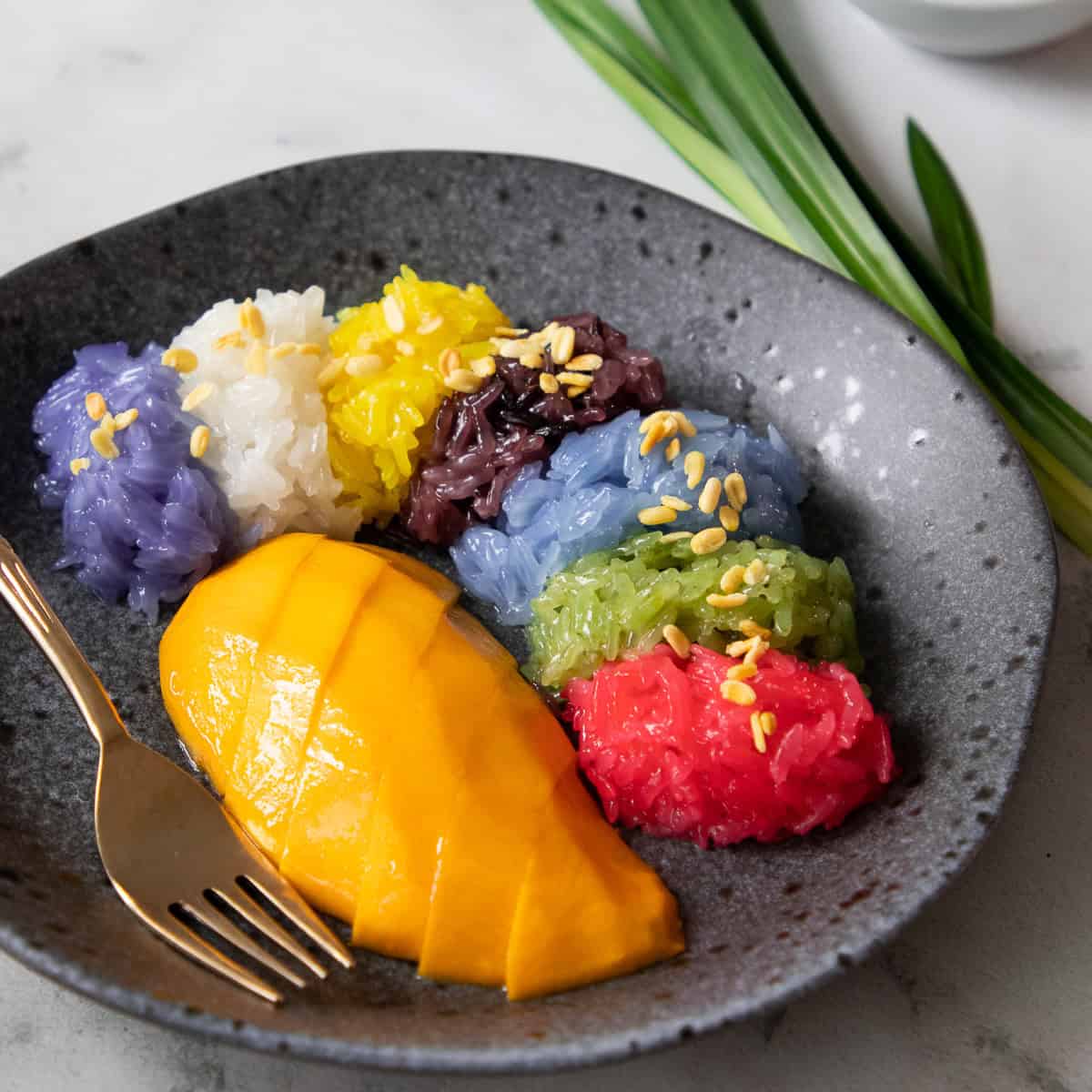
What is Mango and Sticky Rice?
Mango sticky rice is a classic traditional Thai dessert, and in Thai it is called kao niew mamuang ข้าวเหนียวมะม่วง. Kao niew means sticky rice, and mamuang means mango. The sticky rice part of the dessert is made from white long grain glutinous rice that has been steamed and then macerated in a sweet coconut syrup. The rice is then topped with a salted coconut sauce and crispy mung beans.
The mango part of the dessert is simply fresh mango! Of course you've got to get the right kind of mango for this dessert to work, as the varieties are very different. More on this in the ingredient section below.
In Thailand, you can find mango sticky rice just about anywhere, as it is popular amongst Thais and foreigners alike. But for the best mango sticky rice, you should get it from a shop that specializes in it as opposed to a restaurant that sells many things.
Also, even though mango sticky rice is available year around in Thailand, the best time to eat it is during the mango season which is in Thailand's summer; roughly from March until May.
Ingredients and Notes
There are 4 components to Thai mango sticky rice, but the ingredients for each one is incredibly short! Here are important notes about them, and for amounts, see the full recipe card below.
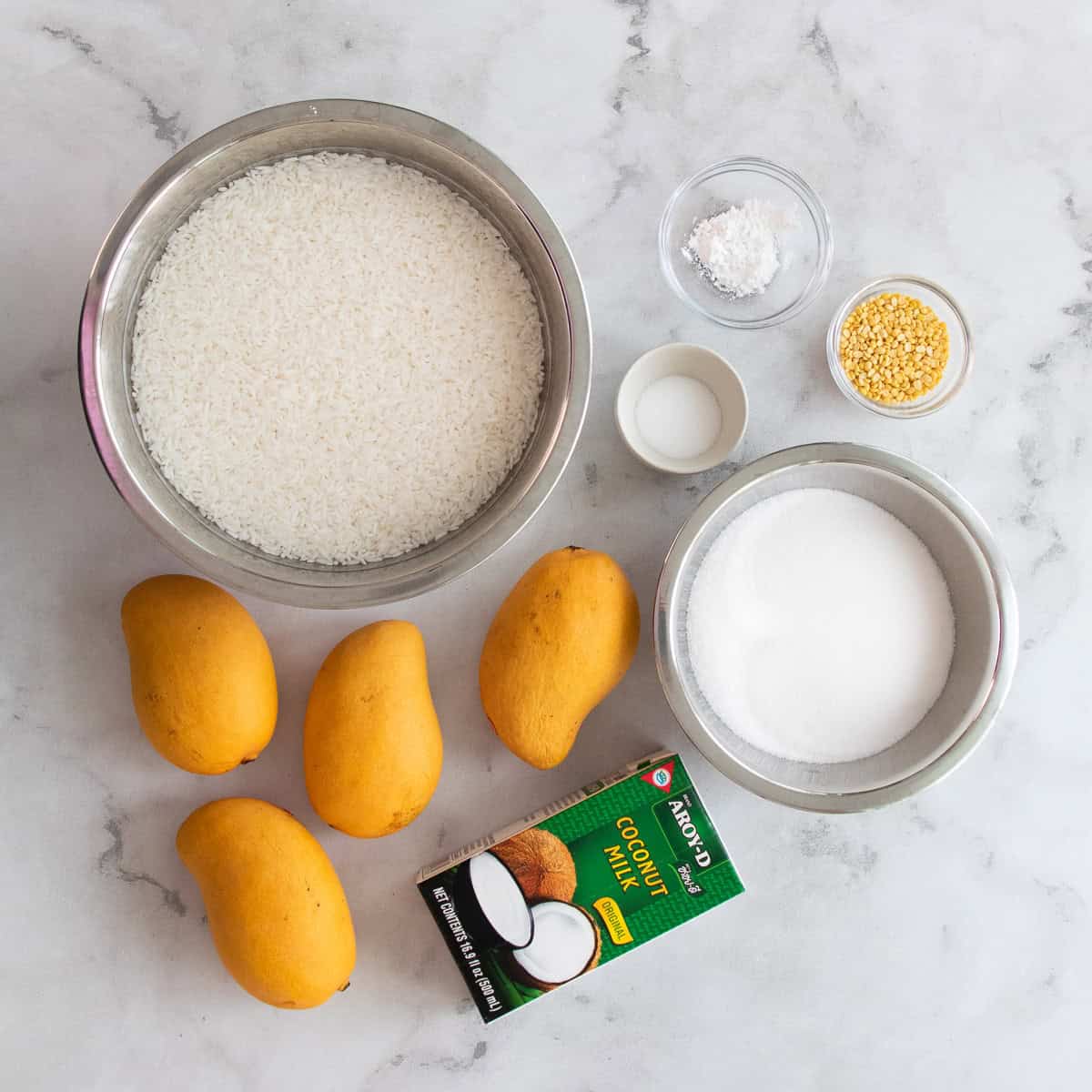
1. Sweet Coconut Sticky Rice
- Thai white glutinous rice, also known as Thai sweet rice or Thai sticky rice. To make sure it is the right kind, ensure it is long grain and a product of Thailand.
- Coconut milk, a good coconut milk is important here. I like Aroy-D in the carton (not the can!) as shown in the pic. Also check out this post about how to choose good coconut milk. Do not use coconut cream for this recipe.
- Salt
- Granulated sugar. While you might be tempted to use palm sugar in Thai desserts, white sugar is used in this recipe to maintain the white colour of the rice. But if you're making a coloured rice, you can substitute half or all of the white sugar with palm sugar.
2. Salted Coconut Sauce
This is a simple yet extremely important component of the mango sticky rice. The salt helps balance out the sweetness and adds moisture and creaminess, so together you end up with a dish that is well balanced and not overly sweet.
- Coconut milk.
- Salt.
- Rice flour or cornstarch. This is just to thicken the sauce so that it will stay on the rice and not run all over the plate, so any starch or flour that you have on hand will do the job.
3. The Mangoes
Mark my words: if the mango is not good, it does not matter how good your rice is.
The quality of the mango makes or breaks this dish, so make sure your mangoes are sweet, ripe and juicy. In Thailand, we use nam dok mai or ok rong mangoes.
In North America, the best mangoes for the job are Manila mangoes, also known as ataulfo or champagne mangoes. Avoid varieties that are fibrous or have a dense, firm texture. Usually the large, round-ish, reddish mangoes don't work well for this.
To ensure ripeness, I wait until the mangoes develop wrinkles on the skin, or even a black spot or two. Those are sure signs of ripeness. At the very least, I wait 3 days after the mangoes have turned completely yellow. I typically buy the mangoes at least a week before serving because most mangoes in stores are still green.
4. Crispy Mung Beans
Though many people consider these optional, I think they make a huge difference because they add an element of crunch. You'll be surprised at how much a little crunchiness adds to any dessert!
All you need is shelled, split mung beans which you can find at many Asian grocery stores. Do not get whole mung beans which are green; the ones you need are yellow, and they should be split in halves.
How to Make Mango Sticky Rice
Here's a bird's eye view of the steps involved, but if it's your first time, I highly recommend watching the full video tutorial to ensure success!
For the sweet sticky rice

- Wash the glutinous rice about 4-5 times until the water runs mostly clear. Then soak the rice in plenty of room temp water for at least 4 hours and up to overnight.
- If you want to colour the rice, you can add the colour to the soaking water (see instructions in the section below).
- Drain the rice very well and place it on a moist (not wet!) muslin or tea towel, then fold the edges of the cloth over the rice. You can steam different colours at once, as long as they don't touch.
- Steam the rice for 20-25 minutes over boiling water. Make sure the rice doesn't cover the entire rack - there should be space around the rice to allow the steam to come up.

- Prepare the coconut syrup. In a pot, combine the coconut milk, sugar, salt; and if you have a pandan leaf handy you can throw it in as well. Cook it over medium high heat, and at the first sign of bubbling, turn off the heat and keep covered until the rice is done. Do not let this syrup reduce.
- Macerate the rice. Shortly before the sticky rice is done, reheat the syrup back up so it is piping hot. When the rice is done, immediately place it into a mixing bowl and pour the hot syrup over the rice. Stir to break up any lumps, then cover with a lid, a plate, or aluminum foil and let sit for 20 minutes. It's very important both the rice AND the syrup are very hot to ensure proper absorption.
- After 20 minutes, fold the bottom of the rice up to the top to help redistribute the liquid, and let sit for at least another 20 minutes or until ready to serve.
- The rice should've absorbed all the liquid and looks plump and shiny, but not mushy. There should be no pooling liquid remaining.
For The Salted Coconut Sauce

- Stir the rice flour in some water until there are no more lumps.
- Combine the rice flour slurry, coconut milk, and salt in a small pot. Cook over medium high heat, stirring constantly, until the mixture comes to a boil.
- Pour into a bowl and let cool. It will not look like much has happened at this point.
- After it has cooled it'll thicken to the perfect consistency. This will keep for up to a week in the fridge.
For the crispy mung beans

- Rinse the beans, add them to a small pot and cover with 2 cups of water.
- Bring the water to a simmer, and as soon as it simmers immediately remove from heat and cover the pot; let sit for 10 minutes. Watch the beans carefully and turn the heat off as soon as the water is bubbling. Do not let them simmer or soak too long or they will overcook.
- Promptly drain and rinse the beans in cold water then dry them on paper towel.
- In a lightly greased pan, toast the beans over medium high heat, stirring frequently, until the beans are dry, crunchy and slightly golden brown. Cool on a plate. These will keep in an airtight container for up to a month.
Assembly

Scoop the rice onto a plate, then drizzle the salted coconut sauce over the rice. Sprinkle the crispy mung beans on top and serve beside fresh mangoes. Enjoy!
Making Colourful Sticky Rice

There are 2 ways to colour the sticky rice: colour the soaking water OR colour the coconut syrup. If using natural dyes, I find it is easier to add the colour to the water than to the coconut syrup, because colours have a hard time infusing into fatty liquid.
If using food colouring, then it will be easier to just stir a few drops into the coconut syrup.
Here are the natural dyes Thai people like to use. The following are formulas for 1 cup of soaking water, which is enough to soak up to 1 cup of sticky rice. Tip: It is much easier to see the dying process in action in the video!
- Green - Pandan leaves + food colouring. Blend 50g pandan leaves with 1 cup of water until mostly fine. If you have a super blender like a Vitamix don't go max power and completely annihilate it as it will become bitter, and all of the fibers won't be caught in a sieve. The rice will not pick up that much green, so I find adding a couple of drops of green food colouring is necessary here for a bright colour.
- Blue - Butterfly pea flowers. Steep 20 dried butterfly pea flowers in ½ cup of hot water for 15 minutes. Drain, then add ½ cup of cold water to cool it down. Make sure the water is room temp before you soak the rice.
- Purplish blue - Butterfly pea flowers + lime juice. After you get the blue water from above, add about 2 teaspoons of lime juice to turn the colour purple. It will look quite purple now, but will turn more blue after steaming.
- Yellow - turmeric. Dissolve ½ teaspoon of turmeric powder in about ¼ cup of hot water and stir to extract the colour. Add ¾ cup of cold water to cool it down. Make sure the water is room temp before you soak the rice.
- Orange - red beets. Grate about ¼ of a beet into 1 cup of room temp water, then strain. The water looks red but the rice will turn orange after steaming.
- Pink - Food colouring. In Thailand we have a type of wood called mai faang that we use to extract pink colour, but since it's not availablee here, you will need to use food colouring.
- Dark purple - black sticky rice. Substitute 25% of the white glutinous rice with black glutinous rice (so if making 1 cup of rice, use ¼ cup black rice and ¾ cup white rice). Pour 1 cup of hot-off-the-boil water over the black rice and cover and steep for at least 30 minutes; or let it go until the water cools down to room temp. If the water is still hot add some ice cubes to cool it down, then add the washed white rice into it and let the two soak together for the required 4 hours. The initial hot soak is necessary for the black rice because it is a whole grain rice, and without the hot soak it will be too chewy.
**You will need slightly less coconut milk in the syrup if making black sticky rice because the black rice does not absorb liquid readily.
Logistical Tip for making multiple colours: I recommend making the same amount of each colour to make the math easy on yourself. Make the syrup in one big batch, then measure the total volume and divide it by the number of colours you have, so you know how much syrup is needed for each batch.
Tips for Success
It sounds like a simple dessert, and it is, but there are a few things to keep in mind to ensure success:
- The sticky rice is best served the day it is made. While you can reheat it, the texture is never as good as when it's fresh. But there are lots you can do to prep ahead of time to make serving day much easier, see advance prep tips below.
- Do not use any other method to cook the rice. Over the years I have shown you many ways to cook sticky rice, including this hot soak sticky rice method. But for this recipe I recommend only using the cold water soak method as shown here. Other methods will yield rice that is on the softer side, which is fine when eaten plain, but it could turn mushy after the syrup gets added.
- Drain the rice VERY VERY well before you steam. If there is a lot of leftover water in the rice, it'll trickle down to the bottom and soak the cloth which will make the bottom of the rice soggy. PS. this is not as much of an issue if you use the traditional bamboo cone steamer as the bamboo can absorbs excess water.
- Use good coconut milk. As you can see, coconut milk plays a large role in this dessert, and it's important to use a good one. My preference is for Aroy-D in the carton, NOT in the can. Coconut milk varies greatly in quality, so to learn more, read my post on how to choose good coconut milk.
- Always use sweet ripe mangoes. There is nothing that ruins mango and sticky rice more than sour or flavourless mangoes!!! This is not a dessert to make out of season.
- If you're using natural dyes for your rice, refrigerate the rice after 4 hours of soaking if not steaming yet. This is to ensure food safety since we have introduced fresh plant materials to the water.
Save this recipe!
Advance Prep Tips
Here are things you can do to prep ahead:
- Make the coconut syrup up to a few days ahead and reheat before macerating the rice.
- Make the salted coconut sauce up to a few days ahead and reheat just until warm or room temp before serving.
- Make the crispy mung beans up to a week ahead and store in an airtight container.
- Soak the rice up to one day ahead, and be sure to steam the rice at least an hour before serving to ensure enough maceration time.
Storage and Reheating Instructions
As mentioned, it's best to serve the rice the day it is made, but leftovers can be refrigerated for up to 3 days and frozen for up to 1 month. Reheated rice will have slightly compromised texture, but it is fine to eat.
To freeze the sticky rice, divide the rice into portions and wrap in plastic wrap. Freeze in a freezer bag with as much air removed as possible.
To reheat refrigerated or frozen sticky rice, cover the rice with a damp paper towel and microwave until piping hot. Halfway through, take it out and break it up into smaller chunks and mix the up for more even heating.
Alternatively, cover with dry paper towel or tea towel and steam it in a steamer until the rice is piping hot. After a few minutes of steaming, break the rice up into smaller chunks for more even heating. The rice will not regain its softness unless it is fully reheated!
Let cool to room temp or slightly warm before serving.
The salted coconut sauce will last at least 1 week in the fridge without any issues. Simply reheat in the microwave or on the stovetop.
To store leftover cut mangoes, cover it well and refrigerate for up to 3 days. It may develop some browning, which is not pretty, but is fine to eat.
Recipe Card

Thai Mango and Sticky Rice
Save this recipe!
Ingredients
Coconut Sticky Rice
- 1 cup white glutinous rice, see notes 1 and 2
- ⅔ cup coconut milk
- ½ teaspoon table salt
- ½ cup sugar
Salted Coconut Sauce
- ½ cup coconut milk
- ¼ teaspoon table salt
- 1 teaspoon rice flour
- 1 Tablespoon water
Others
- 2 Tablespoons shelled and split mung beans
- 3 sweet, ripe mangoes, see note 3
Notes
- White glutinous rice is also labelled as white "sweet rice". Make sure it is long grain and a product of Thailand.
- If making the black sticky rice version, use ¼ cup black sticky rice, ¾ cup white sticky rice, and reduce the coconut milk for the syrup to ½ cup (120 ml). See black rice soaking method in the blog post above.
- The quality of mangoes is so important for this dessert. I prefer Ataulfo mangoes (aka Manila or Champagne mangoes). See more mango tips in the blog post.
FULL VIDEO TUTORIAL
All my recipes come with step-by-step video tutorials with extra tips not mentioned in the blog post, so make sure you watch the video to ensure success. If you enjoy them, consider subscribing to the YouTube Channel to not miss an episode. Thank you!
Subscribe to my YouTube ChannelInstructions
For the sweet sticky rice:
- *If you want to make colourful rice, first prepare the soaking water using instructions in the blog post above.Wash the rice by placing it in a mixing bowl and cover with cold water, then vigorously swish the rice with your hand to release loose starch. Pour off the cloudy water and repeat the process 4 more times or until the water runs mostly clear.1 cup white glutinous rice
- Soak the rice with room temp water for at least 4 hours and up to overnight. If you're using naturally dyed water to soak the rice, refrigerate the rice after 4 hours of soaking if you're not yet ready to steam.While the rice is soaking, make the salted coconut sauce and the crispy mung beans (below).
- Preheat the steamer by bringing it to a full boil over high heat. While you wait for the water to boil, drain the rice very well, shaking off excess water in a sieve until there is no more dripping. Line a steamer rack with moist muslin (not soaking wet!) or a thin white tea towel and place the rice on the cloth. Fold the edges of the cloth over the rice, making sure the rice doesn't cover the entire rack - there should be space around the rice to allow steam to come up. Cover the steamer rack with a lid.
- Steam the rice for 20-25 minutes over rapidly boiling water, until the rice is fully cooked through (it should not be crunchy in the middle).
- While the rice is cooking, make the coconut syrup. Combine the coconut milk, sugar, and salt in a small pot. If you have a pandan leaf handy, tie it into a knot and throw it in for extra aroma. Cook it over medium heat, and as soon as it starts to bubble, turn off the heat and cover. You will need to reheat this once the rice is ready.⅔ cup coconut milk, ½ teaspoon table salt, ½ cup sugar
- Few minutes before the rice is done, reheat the syrup so it is steaming hot then keep covered. When the rice is done, immediately place the rice into a mixing bowl and immediately pour the syrup over the rice. Stir to break up any lumps, then cover with a lid, a plate, or aluminum foil and let sit for 20 minutes.
- After 20 minutes, use a rubber spatula to fold the bottom part of the rice up to the top to help redistribute the syrup, and let sit for at least another 20 minutes or until ready to serve. At this stage the rice will keep at room temp all day.
For the salted coconut sauce:
- Stir the rice flour into the water until there are no more lumps.1 teaspoon rice flour, 1 Tablespoon water
- Combine the rice flour slurry, coconut milk, and salt in a small pot. Cook over medium high heat, stirring constantly, until the mixture comes to a boil. Remove from heat and pour into a bowl. Let cool completely before serving.½ cup coconut milk, ¼ teaspoon table salt
For the crispy mung beans:
- Rinse the beans in cold water and add them to a small pot and cover with about 2 cups of water.2 Tablespoons shelled and split mung beans
- Over medium heat, bring the water to a simmer. Once simmering, immediately remove from the heat and cover the pot for 10 minutes ONLY. Do not over-soak.
- Drain off the cooking water and rinse the beans in cold water. Lay the beans on a paper towel to dry.
- In a lightly greased sauté pan, toast the beans over medium high heat, stirring frequently until the beans are dry, crunchy and start developing a light golden colour.
- Let cool on a plate. This can be kept in an airtight container for up to 1 month.
Assembly:
- Serve the rice beside sweet, fresh cut mangoes. Spoon some salted coconut sauce over the rice and sprinkle with the crispy mung beans.3 sweet, ripe mangoes


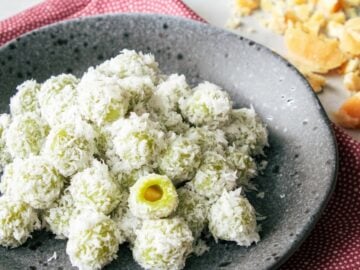

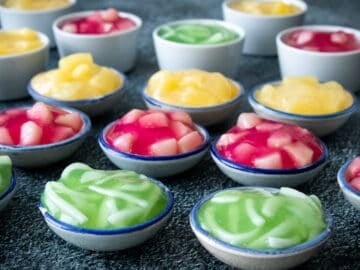
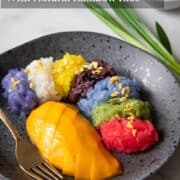
Chris Worth says
After travelling across Thailand and Bali I fell in love with the dish. I have tried a couple of recipes since being home. This one is the BEST, AUTHENTIC AND EASY. Big thank you from my household.
Ron says
Made this today with Jasmin rice left after our meal - incredible! Used ripe bananas instead of mango - also amazing. Didn’t bother to thicken the sauce, but it was one of the best things I’ve ever eaten. Thank you, Pai!!